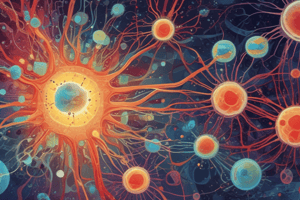Podcast
Questions and Answers
Who was the first person to use the term 'cell'?
Who was the first person to use the term 'cell'?
- Robert Hooke (correct)
- Theodor Schwann
- Matthias Schleiden
- Rudolf Virchow
Prokaryotic cells contain membrane-bound organelles.
Prokaryotic cells contain membrane-bound organelles.
False (B)
What is the main function of the mitochondria?
What is the main function of the mitochondria?
production of energy in the form of ATP
Eukaryotic cells have a membrane-bound ______ and several other membrane-bound subcellular organelles.
Eukaryotic cells have a membrane-bound ______ and several other membrane-bound subcellular organelles.
Match the cell life cycle stages with their descriptions:
Match the cell life cycle stages with their descriptions:
Flashcards are hidden until you start studying
Study Notes
Cell Biochemistry
- Explores molecular mechanisms of normal cellular processes and diseases.
- All higher living organisms, including humans, are made up of cells.
Cell Types
- Two major classes: Prokaryotes and Eukaryotes.
- Prokaryotes: no membrane-bound nucleus, no subcellular organelles, only infoldings of the plasma membrane called mesosomes.
- Eukaryotes: have a membrane-bound nucleus and membrane-bound subcellular organelles.
Cell Theory
- A cell is the basic structural and functional unit of living organisms.
- The activity of an organism depends on the collective activities of its cells.
- The principle of complementarity states that the activities of cells are dictated by their structure, which determines function.
Eukaryotic Cell vs. Prokaryotic Cell
- Eukaryotes:
- DNA is found in the nucleus of the cell.
- Contain membrane-bound organelles (e.g., mitochondria, endoplasmic reticulum, and Golgi complex).
- Cell division involves mitosis.
- Prokaryotes:
- DNA is not enclosed within a membrane.
- Lack membrane-enclosed organelles.
- Usually divide by binary fission.
Molecular Composition of Cell
- Water accounts for about 70-75% of the cell's weight.
- Organic compounds (nucleic acids, proteins, polysaccharides, and lipids) account for 25-30% of the cell's weight.
- Proteins account for 10-20% of the cell's weight.
- Inorganic compounds account for the rest of the cell's weight.
Eukaryotic Cell Components
- Plasma membrane:
- Structure: phospholipid bilayer containing cholesterol and proteins, and some carbohydrates.
- Functions: acts as a physical barrier, regulates material movement, and functions in cell communication.
- Nucleus:
- Structure: enclosed within a double membrane called the nuclear envelope, contains nucleolus.
- Function: contains DNA that serves as the genetic material for directing protein synthesis.
- Cytoplasm:
- Structure: contains organelles and provides support for organelles.
- Function: responsible for various cellular processes.
- Mitochondria:
- Structure: double-membrane-bound organelles containing a circular strand of DNA.
- Function: responsible for the production of energy in the form of ATP.
- Lysosomes:
- Structure: spherical-shaped membrane-bound organelles formed from the Golgi apparatus.
- Function: digest microbes or materials by the cell.
- Endoplasmic reticulum:
- Structure: extensive interconnected membrane network.
- Function: modifies, transports, and stores proteins produced by attached ribosomes.
- Golgi apparatus:
- Structure: series of several elongated, flattened sac-like membranous structures.
- Function: modifies, packages, and sorts materials, and transports them in vesicles.
- Peroxisomes:
- Structure: similar to lysosomes.
- Function: contains enzymes involved in the metabolism of hydrogen peroxide.
- Cytoskeleton:
- Structure: organized network of protein filaments.
- Function: maintains integral structural support and organization of cells.
Cell Membrane Transport
- Passive transport:
- Diffusion: movement of a substance from an area of higher concentration to an area of lower concentration.
- Facilitated diffusion: requires a protein carrier.
- Osmosis: diffusion of water across a selectively permeable membrane.
- Active transport:
- Uses energy (ATP) provided by the cell.
- Example: sodium-potassium activated ATPase (sodium pump).
- Exocytosis and endocytosis:
- Exocytosis: bulk movement of substances out of the cell by fusion of secretory vesicles with the plasma membrane.
- Endocytosis: bulk movement of substances into the cell by vesicles forming at the plasma membrane.
Cell Life Cycle
- Interphase:
- Longer phase of the cell cycle where the cell is active and preparing for cell division.
- DNA molecule is duplicated exactly in a process called DNA replication.
- Cell division:
- Mitosis consists of four stages: prophase, metaphase, anaphase, and telophase.
- Result: two daughter nuclei, each identical to the mother nucleus.
Studying That Suits You
Use AI to generate personalized quizzes and flashcards to suit your learning preferences.




